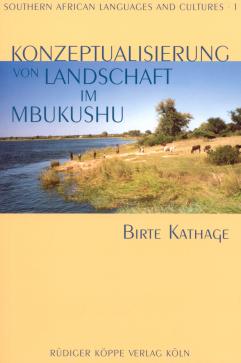
Konzeptualisierung von Landschaft im Mbukushu (K.333/K.43) Bantusprache in Nord-Namibia)
Author: Birte Kathage. Series edited by: Axel Fleisch, Wilhelm J.G. Möhlig †.
Series: SAL Southern African Languages and Cultures Volume 1
2004273 pp.
4 maps, 33 b/w photos, 7 graphs, 2 diagrams, 16 tables, appendix
Text language(s): German
Format: 160 x 240 mm
510 g
Paperback
€ 49.80
Buy 'Konzeptualisierung von Landschaft im Mbukushu (K.333/K.43) Bantusprache in Nord-Namibia)' as a downloadable PDF document directly from our online shop »
Order 'Konzeptualisierung von Landschaft im Mbukushu (K.333/K.43) Bantusprache in Nord-Namibia)' as print edition »
Mbukushu is a Bantu language (Guthrie K.333/K.43) which is spoken mainly along the Kavango river in the Northeast of Namibia. The major items of the landscape are the Kavango river, lined with fertile floodplains and river terraces, and the Kalahari sand plateau which is partly covered by woodlands and parallel drainage channels of dry rivers. During her fieldwork the author collected linguistic and non-linguistic data on the conceptualization of this semi-arid landscape.
The data collection was carried out on the basis of linguistic and cognitive anthropological methods. The findings of the study lead to the conclusion that the mental process of conceptualization is based on universal cognitive principles which leave open cultural variation within outer limits. The methods of data collection and analysis are suited to identify and systematically describe culture-specific variation. Thus the study contributes substantially to the compilation of an empirical basis on conceptualization which is suitable to further develop explanatory approaches for a theory of cognitive linguistics and in particular of cognitive semantics.
Under these links you will find publications on the history of the Mbukushu and their neighbouring ethnic groups, as well as studies of ecosystems and of the conceptualization of nature, environment, space, motion and emotion in African languages and cultures:
Accompanying material:
- Die südafrikanische Militärverwaltung (1915–1920) und die frühe Mandatszeit (1920–1936) in der Kavango-Region / Namibia
(ISBN 978-3-89645-360-0 ) - Institutioneller Wandel und Ressourcenkonflikte
(ISBN 978-3-89645-255-9 ) - Living with the Lake
(ISBN 978-3-89645-216-0 ) - Medicine Experts of the |Xam San
(ISBN 978-3-89645-147-7 ) - Räumliche Orientierung in nilotischen Sprachen
(ISBN 978-3-89645-661-8 ) - Siedler am Tschadsee
(ISBN 978-3-89645-218-4 ) - The |Xam and the Rain
(ISBN 978-3-89645-866-7 ) - The Mbukushu in Angola
(ISBN 978-3-89645-350-1 )
Cross-reference:
- Anthropologie des Raumes
(ISBN 978-3-89645-217-7 ) - Comparing African Spaces
(ISBN 978-3-89645-013-5 ) - Encoding Emotions in Swahili
(ISBN 978-3-89645-715-8 ) - Encoding Motion – Case Studies from Africa
(ISBN 978-3-89645-505-5 ) - Environmental and Cultural Dynamics
in the West African Savanna
(ISBN 978-3-89645-478-2 ) - Language, Identity, and Conceptualization among the Khoisan
(ISBN 978-3-89645-143-9 ) - Motion in Datooga
(ISBN 978-3-89645-668-7 ) - Multidisciplinary Views on the Horn of Africa
(ISBN 978-3-89645-683-0 ) - Perception of the Invisible
(ISBN 978-3-89645-603-8 )
Reviews
Thomas Widlok in Journal of African Languages and Linguistics, 28/2, 2007, 251-253
| « back | Print version | [top] |
 Books
Books Audio
Audio Biographies
Biographies Series
Series Festschrifts
Festschrifts Journals
Journals